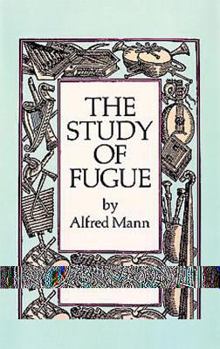The Study of Fugue
Select Format
Select Condition 
Book Overview
Features a historical survey of writings on the fugue from the Renaissance to the present as well as 4 18th-century studies: works by J. J. Fux, W. F. Marpurg, more. Includes introductions,... This description may be from another edition of this product.
Format:Paperback
Language:English
ISBN:0486254399
ISBN13:9780486254395
Release Date:August 1987
Publisher:Dover Publications
Length:368 Pages
Weight:0.84 lbs.
Dimensions:0.7" x 5.4" x 8.5"
Customer Reviews
5 ratings
Another great music theory classic
Published by Thriftbooks.com User , 14 years ago
This is the sequel to Mann's translation of part one of Fux's "Gradus ad Parnassus", (which is the section on species counterpoint, and which is a prerequisite to this book.) "The Study of Fugue" includes the best of Fux's instruction on fugue (part two of the "Gradus ad Parnassus"), plus additional material from 3 more important 18th century writers, two being the teachers of Mozart and Beethoven respectively, and one an associate of J. S. Bach. Alfred Mann's detailed history of fugal theory makes up the first part of the book. If you combine this with the similar exposition in the first part of Knud Jeppesen's "Counterpoint", you have a wonderful overview of the history of contrapuntal music theory from the medieval period up to the dawn of romanticism. Jeppesen's "Counterpoint" does contain a short appendix on fugue, but many details are left out. Although Jeppesen's book is a valued resource in my library, reading Mann on fugue exposes two shortcomings in Jeppesen which are not apparent to the reader of Jeppesen alone (I reviewed Jeppesen's book separately but some comments are relevant here.) (1) Jeppesen's insistence on correcting Fux's faulty understanding of Palestrina's style (which he does in exhaustive detail) misses the point that the species exercises are only preliminaries to writing Baroque fugue, and are not really intended to reproduce Renaissance style - that is, Fux's use of Palestrina as a model is more a literary device than a practical exercise. So you can give Fux a break; Jeppesen is right about the details of Palestrina's style, but Fux's book is still valid in itself as a manual of Baroque practice. (2) Jeppesen fails to properly or fully explain the function of the plagal and authentic modes as the organizing force behind the ranges of the four voices - soprano, alto, tenor, bass - and the huge effect that this organization had on the evolution of the fugue by in turn organizing the development of the "tonal answer". One finishes Jeppesen's book still wondering why the plagal modes existed at all; one finishes Mann's book understanding that the "twelve modes" of Glareanus (six plagal and six authentic, an expanded set of the original eight medieval "church modes" which was current in the 16th and 17th centuries) were an active part of musicians' thinking well into the 18th century, and understanding that this in turn is important to understanding fugal practice. Each of the four 18th century authors showcased by Mann has his own repertory of fugal tricks and techniques, and they fill in each other's weak points pretty well, so it's a blessing to have them all together in one book. The fluidity of fugal practice is emphasized, and it is clear that there are lots of ways to write a fugue, and that there is no one absolute formula which must be dogmatically adhered to.
It is worth 10 times the price
Published by Thriftbooks.com User , 17 years ago
Get this book, it is so great, beyond words, Alfred Mann is like the Saint of Musical theory! What it contains is a complete study of the subject fugue - through the works of 4 theorists, Fux, modal-style, Marpurg, student of bach, Albrechtsberger, teacher of Beethoven Padre Martini, most famous theorist at the time of Mozart, and at one point the teacher of Mozart(the book contains a Mozart fugue, and the "corrections" done by Martini) Before hand it may proove essential to know the basic theory - start with "Gradus ad Parnasum"(same author) and get a good book of Functional Harmony as well. After that, this book will be all you need to start fugal writing. Good luck!
Great for students and enthusiasts.
Published by Thriftbooks.com User , 21 years ago
This work, which essentially includes a large portion of work by Fux, is great for the person studying counterpoint (fugues more specifically) or the person with a deep interest in the subject. I am a student with a deep interest in the subject and I enjoy this study quite well. If your ears perk up when someone says fugue or counterpoint then check this book out!!
Unique!
Published by Thriftbooks.com User , 22 years ago
It's not very simple to find books about musical forms and composition. This is an excelent title. The text is very rich and complete and it's possible for the reader to do your own fugues. Of course is not for begginers, it's necessary that you have a good knowledge in music, including counterpoint. Counterpoint is aborded, of course, but if you'd never seen the subject, the read may be a little boring.The good news are: If you like music, if you have studied for a long time and would like to begin with your own compositions, this is a mandatory book.
required reading for composers, theorists, and historians
Published by Thriftbooks.com User , 24 years ago
The translator distributes his English version of Fux's "Gradus ad Parnassum" between this and "The Study of Counterpoint". I recommend that every composer and theorist pick up copies of Mann's "The Study of Counterpoint" and "The Study of Fugue" and work through the Fux, and that every music historian be familiar with these two works.Also recommended: "Pentatonic Scales for the Jazz Rock Keyboardist" by Jeff Burns.




